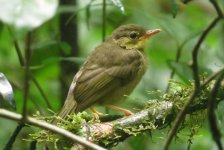For whatever reason, I didn't see that you had all responded to my question above. Apologies for the delay.
I was on the trip with "tapaculo" this November when Julien pointed out what he called a flock of Dusky Tetraka. I'm skeptical about this ID, but trying to learn more. While in the presence of the birds, I focused on getting sound recordings while “tapaculo” and the others focused on gathering photo evidence. Here are some of my observations and thinking-out-loud ID process. Feedback welcome.
pro Spectacled Tetraka evidence (visual): From the first glance, they seemed too elongated along the bill-to-tail axis to match the illustration in the Hawkins field guide. The posture of the bird was also more horizontal than upright, as is indicated for Dusky. Also birds in the flock that were begging (presumably juveniles) appeared to have Dusky/Spectacled adult plumage, not the dark brown juvenile illustrated in the field guide. These presumed juveniles also had lighter colored spectacles (as in Tapaculo’s posted pic) while the guide illustrates no such facial markings.
neutral evidence (visual): My best looks at the birds were when they were on vegetation a little ways above the ground. However it seemed that these birds were also on the ground itself. I’m not sure that I can say that they spent more time one place than the other because the thick undergrowth seemingly biased my looks at them to when they were higher above the ground.
contra Spectalcted Tetraka evidence (visual): When do juvenile Dusky Tetrakas assume adult-like plumage? I don’t know if this outlandish or not, but could the adults still be feeding young birds for a short while after the young ones take on the plumage of adults?
Audio evidence (I’m still working on this one): The sound of the birds is what first alerted Julien to their presence and identity as Dusky Tetrakas. I did get some serviceable audio recordings. These recordings are slanted towards the sounds of the presumed juveniles rather than the presumed adults. I’ve been searching for audio references without great success. Spectacled Tetraka recordings are available on the internet (20 at xeno-canto.org and 1 on MSU’s avocet project). The only Dusky Tetraka recording I could find online is a single record on the avocet website (
http://www.avocet.zoology.msu.edu/recordings/593). The poster of this audio recording notes that it sounds different from the Dusky Tetraka track on the Bird Sounds of Madagascar cd, but also notes that they couldn’t find anything else on that CD that corresponds to the posted recording. The Bird Sounds of Madagascar is not available for purchase anywhere that I can find. I’m from the USA, and as far as I can tell, only a few institutions in this country have the CD. The ones that I’ve encountered don’t lend out the CD, but instead require the potential CD user to listen to the CD on-site. (Unfortunately one such institution is a short bus ride away from me, yet after much searching, they admitted that the CD is lost and that they can only find the booklet that came with it.) The other, older cd of Madagascar bird recordings that I’ve seen mentioned online does not contain the Dusky Tetraka (and I haven’t been able to find a copy of it either). In conclusion, my study and expertise in interpreting audio files is not sufficient for me to make a conclusion at this time, but I have not yet given up hope.
My next steps: Email New York University and ask if it might be possible to get a track or two from their copy of the Bird Sounds of Madagascar CD without traveling to their library’s listening room. Send a similar email to the British Library, the producers of this CD.
Questions: Does anyone know how to obtain a copy of the camera trap photo mentioned in the original post? Does anyone know of a museum or other collection in possession of a Dusky Tetraka skin?





